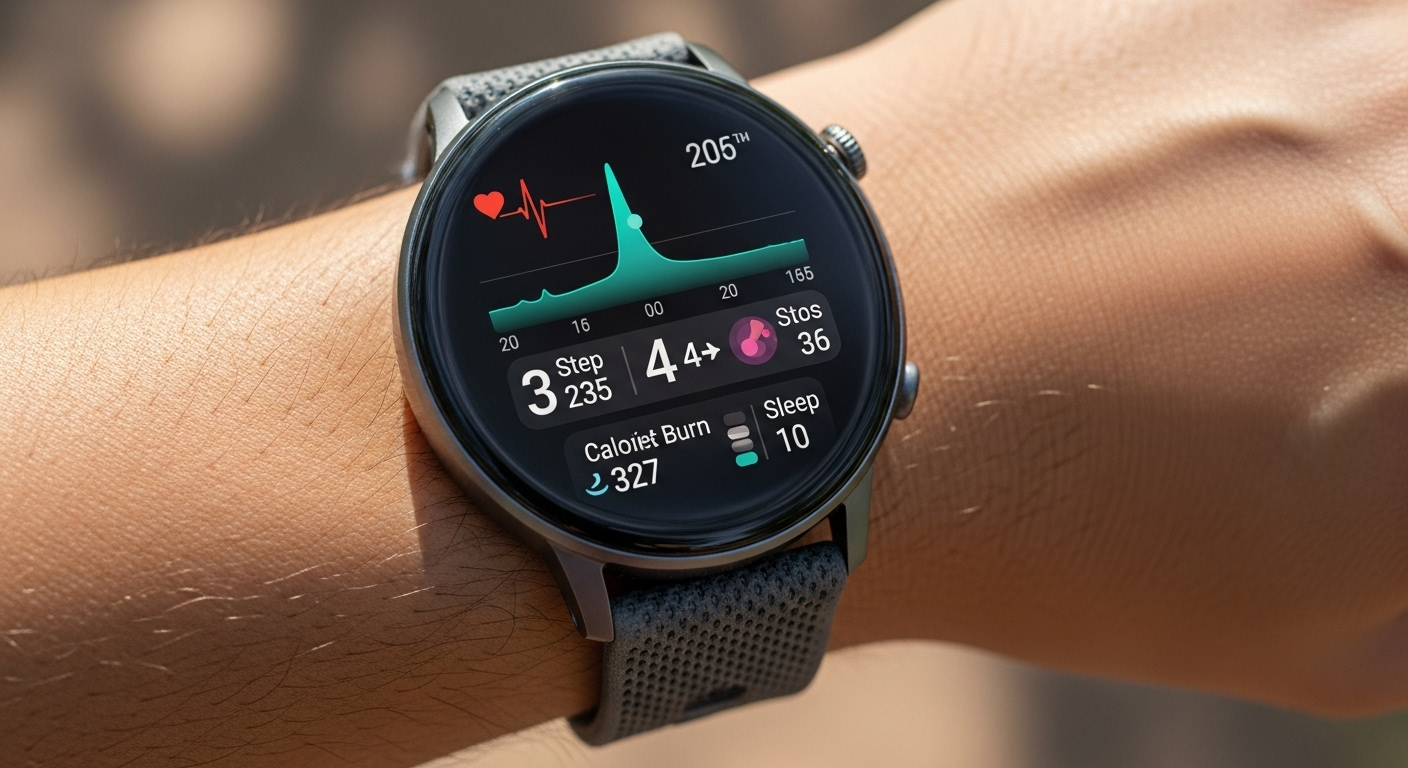The Evolving Role of the Smart Watch for Health Monitoring
The Evolving Role of the Smart Watch for Health Monitoring
Once primarily a novelty item or a basic fitness tracker, the smart watch has steadily evolved into a sophisticated personal health companion. These compact devices, worn on the wrist, are increasingly equipped with an array of sensors designed to monitor various physiological metrics, offering users a new level of insight into their well-being. This transformation underscores a broader shift in how individuals approach personal health management, moving towards proactive data collection and self-awareness. The integration of advanced biosensors makes the smart watch for health a significant topic for discussion in contemporary health technology.

From Pedometer to Personal Health Hub: A Brief Evolution
The journey of wearable technology from simple pedometers to the advanced smart watch for health we see today has been rapid and impactful. Early fitness trackers focused almost exclusively on step counts and basic calorie estimates. Over time, manufacturers began integrating heart rate sensors, transforming these devices into more comprehensive fitness tools. The true paradigm shift, however, occurred with the advent of smarter operating systems and more powerful microprocessors, allowing for the inclusion of multiple, more precise health sensors and the ability to process and interpret complex data directly on the wrist. This evolution has positioned the modern smart watch for health as a crucial interface between an individual and their physiological data.
Key Health Monitoring Capabilities of a Smart Watch
Modern smartwatches are packed with sensors that provide a range of health-related data. Understanding these capabilities is essential to appreciate the potential and limitations of using a smart watch for health insights.
Heart Rate Monitoring
- Continuous Tracking: Most contemporary smartwatches offer continuous heart rate monitoring, logging beats per minute (BPM) throughout the day and night. This data can reveal trends in resting heart rate, which is a key indicator of cardiovascular fitness.
- Abnormal Heart Rate Alerts: Many devices can notify users if their heart rate appears unusually high or low while they are inactive, potentially flagging conditions that warrant further medical attention.
- Exercise Zones: During workouts, heart rate tracking helps users stay within specific training zones, optimizing their physical activity for fat burning, cardiovascular improvement, or peak performance.
Electrocardiogram (ECG/EKG) Functionality
- Detecting Atrial Fibrillation: Certain advanced smartwatches incorporate an ECG sensor, which can record the electrical signals of the heart. This feature is particularly notable for its ability to detect signs of atrial fibrillation (AFib), a common form of irregular heart rhythm. Users typically initiate a reading by touching a finger to the device's crown or bezel.
- Insights, Not Diagnosis: It is crucial to understand that while an ECG on a smart watch for health can provide valuable data, it is not a medical-grade diagnostic tool. It offers insights that can be shared with a healthcare professional for further evaluation.
Blood Oxygen (SpO2) Tracking
- Measuring Oxygen Saturation: SpO2 sensors, often using pulse oximetry, estimate the percentage of oxygen in the user's blood. Healthy individuals typically have SpO2 levels between 95% and 100%.
- Relevance: While not a primary diagnostic tool, consistent low SpO2 readings, especially during sleep, could indicate underlying respiratory issues or sleep-related breathing disorders. The data collected by a smart watch for health can serve as a preliminary indicator.
Sleep Tracking
- Sleep Stages Analysis: Smartwatches with advanced accelerometers and heart rate sensors can often differentiate between light, deep, and REM sleep stages, providing a detailed breakdown of a user's sleep architecture.
- Sleep Quality Metrics: Beyond stages, these devices track total sleep duration, interruptions, and variability, offering a comprehensive view of sleep quality. Understanding sleep patterns through a smart watch for health can highlight habits that might be detrimental to overall well-being.
Activity and Fitness Tracking
- Steps, Distance, Calories: The foundational elements of fitness tracking remain central to any smart watch for health. These metrics help users understand their daily activity levels and caloric expenditure.
- Workout Recognition: Many devices can automatically detect and log various types of workouts, from walking and running to swimming and cycling, providing performance metrics and heart rate data specific to those activities.
- Reminders to Move: Sedentary lifestyle is a significant health concern. Smartwatches often include features that remind users to stand up and move after periods of inactivity, promoting greater movement throughout the day.
Stress Monitoring and Management
- Heart Rate Variability (HRV): Some smartwatches estimate stress levels by analyzing Heart Rate Variability (HRV), which is the variation in time between heartbeats. Lower HRV can sometimes be associated with higher stress.
- Mindfulness Prompts: Based on perceived stress levels, some devices offer guided breathing exercises or mindfulness prompts to help users manage stress in real-time.
Temperature Sensing
- Emerging Capability: Body temperature sensing is an increasingly common feature. While not a clinical thermometer, these sensors can track baseline skin temperature trends, which can be useful for cycle tracking, illness detection (especially fever), or monitoring environmental changes.
- Trend Analysis: The value often lies in observing changes from a personal baseline over time, rather than a single absolute reading.
Fall Detection and Emergency Features
- Safety Net: For elderly individuals or those at risk of falls, certain smartwatches include sophisticated accelerometers and gyroscopes capable of detecting a hard fall. Upon detection, the device can automatically contact emergency services or pre-selected contacts if the user doesn't respond.
- Emergency SOS: Many smartwatches also offer an emergency SOS feature, allowing users to quickly and discreetly alert authorities or contacts with their location during critical situations. This aspect significantly enhances the protective capabilities of a smart watch for health.
Understanding Data Interpretation and Privacy Considerations
Insights, Not Medical Diagnoses
It is paramount to reiterate that data collected by a smart watch for health is intended for informational and trend-tracking purposes. These devices are not regulated as medical devices in the same way clinical equipment is, and their readings should not replace professional medical advice, diagnosis, or treatment. Abnormal readings or persistent concerns should always prompt a consultation with a qualified healthcare provider. The goal is to provide users with actionable insights to discuss with their doctors, fostering a more informed dialogue about their well-being.
Data Privacy and Security
The extensive health data collected by smartwatches, including highly sensitive physiological metrics, raises significant privacy concerns. Users should be aware of how their data is collected, stored, and potentially shared. Reputable device manufacturers typically implement robust security measures and adhere to privacy policies, but understanding these is crucial. The integration of a smart watch for health into a personal data ecosystem requires careful consideration of personal information protection.
Integration with Health Ecosystems
Many smartwatches integrate with broader digital health platforms, allowing users to view their data over time, identify trends, and potentially share information with their healthcare providers (with explicit consent). This integration aims to create a more holistic view of an individual's health data, making it easier to track progress towards health goals.
Practical Considerations for a Health Smartwatch
When considering how a smart watch for health fits into one's lifestyle, several practical factors come into play, distinct from specific product recommendations.
Accuracy vs. Convenience
The convenience of having health monitoring on the wrist is undeniable. However, users should understand that while accuracy has significantly improved, consumer-grade wearables may not always match the precision of dedicated medical instruments. The utility often lies in detecting trends and anomalies over time rather than pinpointing exact measurements.
Battery Life
Continuous monitoring, especially with advanced sensors, can be power-intensive. Battery life varies greatly among devices and is a critical factor for users who desire uninterrupted health tracking, particularly for sleep analysis or multi-day excursions.
Comfort and Design
For a device intended for 24/7 wear, comfort and aesthetic appeal are important. The physical design, strap material, and overall weight influence daily usability and adherence to wearing the device.
Ecosystem Compatibility
A smart watch for health often functions best within a specific digital ecosystem, typically tied to a smartphone platform. Ensuring seamless integration with one's existing devices and preferred health applications can significantly enhance the user experience and data utility.
Water Resistance
For individuals interested in swim tracking or simply wanting to wear their device without concern during showers or in wet environments, a high level of water resistance is a practical necessity.
The Future Landscape of Wearable Health Technology
The trajectory of the smart watch for health suggests a future where these devices become even more integrated into preventative and personalized healthcare. Ongoing research is exploring non-invasive methods for monitoring parameters like blood pressure and glucose levels, which could revolutionize personal health management. The combination of increasingly sophisticated sensors, advanced algorithms, and artificial intelligence promises to deliver even more accurate and insightful health data. Furthermore, the role of these wearables in remote patient monitoring and telemedicine is likely to expand, providing healthcare providers with continuous data streams to better manage chronic conditions and prevent acute events.
The focus will likely shift beyond mere data collection to more proactive coaching and personalized interventions, helping users make better health decisions based on their unique physiological responses. As these technologies mature and gain further clinical validation, the smart watch for health is poised to become an indispensable tool in empowering individuals to take a more active role in their well-being.
Conclusion
The smart watch for health has undeniably transformed personal wellness monitoring, offering an unprecedented window into our physiological states. From tracking heart rate and sleep patterns to providing advanced ECG and SpO2 readings, these devices empower individuals with data that can inform lifestyle choices and facilitate more meaningful conversations with healthcare providers. While offering considerable advantages in promoting awareness and proactive health management, it remains crucial to view these wearables as supplementary tools. They provide valuable insights into trends and anomalies, but they do not replace the expertise of medical professionals. As the technology continues to evolve, the smart watch for health will likely play an even more integral role in our understanding and stewardship of personal well-being, fostering a future where informed health choices are more accessible than ever before.











